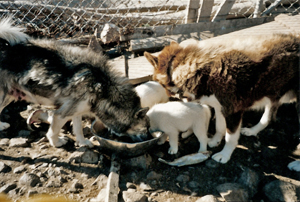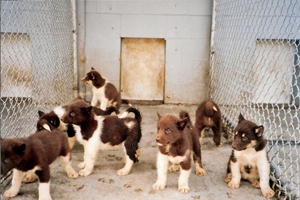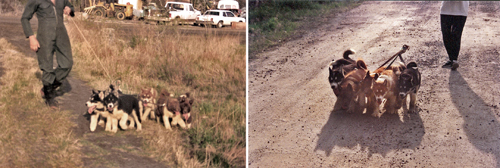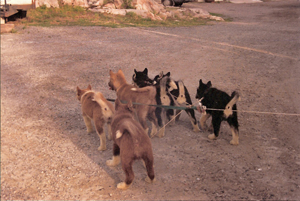From the Editor: The Season for Sharing and Giving
Investigation of the pre-Columbian Ancestry of Today's Dogs of the Americas
Raising Eskimo Dog Puppies for Use in a Fan Hitch
Stareek and Tsigane
In the News
Baker Lake, Nunavut and the Canadian Animal Assistance Team (CAAT)
The End of the Beginning: The First Five Years of Veterinary Services in Baker Lake, Nunavut
Fan Mail
Book Review: The Meaning of Ice
IMHO: Finding Purpose in Retirement
Navigating This Site
Index of articles by subject
Index of back issues by volume number
Search The Fan Hitch
Articles to download and print
Ordering Ken MacRury's Thesis
Our comprehensive list of resources
Defining the Inuit Dog
Talk to The Fan Hitch
The Fan Hitch home page
Editor: Sue Hamilton
Webmaster: Mark Hamilton
The Fan Hitch welcomes your letters, stories, comments and suggestions. The editorial staff reserves the right to edit submissions used for publication.
Contents of The Fan Hitch are protected by international copyright laws. No photo, drawing or text may be reproduced in any form without written consent. Webmasters please note: written consent is necessary before linking this site to yours! Please forward requests to Sue Hamilton, 55 Town Line Rd., Harwinton, Connecticut 06791, USA or mail@thefanhitch.org.
This site is dedicated to the Inuit Dog as well as related Inuit culture and traditions. It is also home to The Fan Hitch, Journal of the Inuit Sled Dog.
by William (Bill) Carpenter2 “Qimmiliriji” (The Dog Man)
Background
You can refer to these dogs as the Inuit Sled Dog or the Inuit Dog as is often referenced in The Fan Hitch journal or Canis familiaris borealis as has been used in some papers. The current name used by many of us in the North and by the southern dog breeding organization that recognizes various breeds of dogs, e.g. the Canadian Kennel Club (CKC) (and other International authorities), at my suggestion (and supported by the Inuit Cultural Institute at the time) is Canadian Eskimo Dog. This was to differentiate it from the Greenland Dog, which is recognized in Europe. In line with the recent recognition by the Government of Nunavut it would be politically correct to call our northern dog “Canadian Inuit Dog”, however the CKC breed standard does refer to the aboriginal name of Qimmiq which was acceptable at the time to the Inuit who were consulted.
With the assistance of Ken MacRury, then of Iqaluit, I also wrote the “official breed standard” for the Canadian Kennel Club as they had requested an update under a new format from the previous short version when it was called simply “Eskimo” dog. At the time I did have contact with the Inuit Cultural Institute that used to be in Arviat (Eskimo Point). We discussed the English name to be used and their view at the time was that as long as there was some reference to “Qimmiq” as being the name that Inuit used, there was no problem with using the name “Canadian Eskimo Dog” as the English name. Nunavut has selected the Canadian Inuit Dog (Canis familiaris borealis) to be the official animal of the new territory.
As far as I can determine, the first Europeans in the north made reference to the dogs as follows: Eskimo’s sledge dog, which then became Eskimo Sledge (sled) Dog, and later evolved to Eskimo Dog or even the French spelling of Esquimaux. Eskimo Dog then got abbreviated to Eskimo and again in layman language evolved to Eskie then on to Uskie and finally to Huskie or Husky. At one period in the history of the CKC, the breed was even called the Eskimo Husky which was a redundant use of words.
However if there is one common image that comes to mind when we think of this breed of dog, it is the “fan hitch” configuration of driving or controlling these dogs as they pulled sledges or komatiks. It is well known that prior to European contact in the north, the number of dogs per family group was very small so a single line on each pulling dog was all that was necessary. If further reference is required I suggest that we look at the cultural references of the Thule and Inuit cultures as well as the earlier Dorset culture. Prior to WWII the fan hitch or single pulling line per dog was likely the common way of driving Eskimo Dogs from Alaska to the Eastern Arctic; however due to the influence of the American Army, dog teams as far to the east as Paulatuk and Ulukhaktok (Holman) were often driven in the so-called double tandem style and even included the use of a wooden spreader bar behind the harness of each dog.3
Inuit were hunters and keepers of a domestic animal: namely the sled dog and as stated by the researcher4 sled dogs have different relationships with people, in contrast to wild or hunted animals, and therefore as I see it warrant special attention as to how they are incorporated into the interdependent relationship with hunters.
Sled or pack dogs have been perceived as an integral part of traditional life in the Arctic. This concept stems from our knowledge of the way of life of recent Thule and modern Inuit peoples, where dogsledding has been an important means of transportation. In contrast, the archaeological record of preceding Paleoeskimo5 peoples indicates that dogs were sparse and probably locally absent for substantial periods. In fact, if we consider the overall archaeological history, it would be a surprise to find that dogs regularly played a significant role prior to about one thousand years ago.
Training Puppies
My approach to training Eskimo Dog puppies for use in a fan hitch6 came from my earlier experience with Springer Spaniel hunting or field trial dogs (not show dogs). What I had learned was the fact that dogs bred for a specific purpose, e.g. hunting dogs, had an instinctive behavior when it came to performing certain tasks. As very young puppies field trial or hunting Springer Spaniels loved to retrieve objects and were very excited by the scent of game birds and/or rabbits.
Similarly I learned that Eskimo Dog puppies thrived on so-called “pack behavior” with each other during feeding and/or play as the norm, with their pecking order involving dominant and subordinate behavior with each. The other key aspect of their instinctive behavior was their love of pulling, especially when given the opportunity together as young puppies as a pack or family group.

photos: B. Carpenter
However well in advance of training for pulling came the handling and feeding of a litter of puppies. This started at a very young age with plenty of touching, handling and talking to them within the first 10 days after birth. By the age of 2 to 3 weeks I was even dipping their tiny mouths into a watery slush mixture of fish and red meat.

photo: B. Carpenter
It should be noted that when ever possible (from the time of mating) I had both the dam and sire of the pups together and present as well bonded dogs with the puppies from the time of birth.
I had many cases of both the mother and father of puppies regurgitating partially digested food to their offspring which made my feeding of puppies and having them imprint on me an easy task. As did Ken MacRury I aimed for weaning puppies at the age of 5 weeks7 so as to prevent any natural feral behavior that might occur with little or no human contact after that age.

photo: B. Carpenter
Weaned puppies looking like miniature adults and ready for initial fan hitch training.
I weaned puppies not as an abrupt process, but rather over a phased period. This meant that although the pups were being fed from a large dish and would eagerly follow me as I pulled the dish around, I did bring their mother close by and after the pups had eaten I let them loose to visit the mother and get a bit of milk by nursing on her.
This event gradually turned into the pups following the mother who was led by someone else while I had the pups all under control of stringed leashes.

photos: B. Carpenter
They eagerly pulled on their lines as they followed their mother.
This all became a daily repetitive training exercise and could involve them following any adult dog (not just their mother) and often over the same familiar route.

photo: B. Carpenter
As the puppies reached 3 months of age they would routinely walk as a pack ahead of me on wide trails or the winter ice of Great Slave Lake (GSL) eagerly straining to stay together and ahead of me.
Often around the age of 4 months I would outfit them with miniature harnesses to allow more comfortable pulling than could be done by lines on their collars. What I found quite amazing was how much they enjoyed it and would gather around me as I called them to me to go on a short training run. I even saw them select their own position in their pulling pack or fan hitch which meant a less tangled set of lines and gradually one or two pups worked their way to the front showing potential for lead dogs. Giving voice commands such as “straight on”, “left or right’ plus “whoa” for stop, etc. was all part of training.
Conclusion
The ultimate reward for me after training many puppies was driving my team of adult dogs in a fan hitch on the Arctic Ocean as I did for 29 days in April & May of 1979.
photo: B. Carpenter
This trip was the S. M. Hodgson Canadian Eskimo Dog Sledging Expedition8 from Resolute to Cape Eyre (71º 50’ north latitude & 96º 32’ west longitude) on the Prince of Wales Island just off the Franklin Strait.
Endnotes:
1 “The Inuit of Arctic
Canada called this dog “Qimmiq”. This breed of
dog with Inuit occupied the coastal and archipelago area
of what is now Arctic Canada. (The Canadian Kennel Club
breed standard for the Qimmiq (Canadian Eskimo Dog),
cited in the Canadian Kennel Club’s Book of Dogs
– Centennial Edition.)
2 I am still one of a
handful of people who use the term “Eskimo Dog” as did
my colleague and friend the late John McGrath.
3 1974 -1976; Personal
communication with Inuvialuit and Inuit Elders in the
communities of Tuktoyaktuk, Paulatuk and Ulukhaktok.
4 1997; The Unique
Role of Sled Dogs in Inuit Culture: An Examination of
the Relationship between Inuit and Sled Dogs in the
Changing North, Kerry Ann Shannon.
5
2001; Paleoeskimo Dogs of the Eastern
Arctic, Darcy F. Morey and Kim Aaris-Sørensen.
6 I was fortunate to live
in Yellowknife and later at Moraine Point as both
locations being on Great Slave Lake allowed the use of
driving my dogs in a fan hitch which was not possible on
forested trails in the NWT.
7 Personal communication
with Ken MacRury on numerous occasions over several
years.
8 1979; This
trip was to honour the visit to the Northwest
Territories of H.R.H. The Prince of Wales who opened The
Prince of Wales Northern Heritage Centre in Yellowknife,
NWT, Canada on April 3rd, 1979. The
expedition also paid tribute to Stuart Milton Hodgson,
Commissioner of the Northwest Territories (1967 – 1979),
on the occasion of his retirement and in gratitude for
his efforts to preserve northern culture and history.